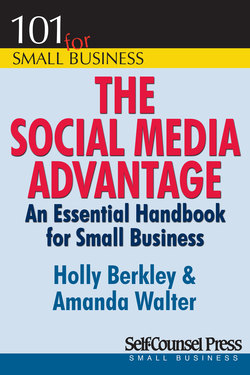Читать книгу The Social Media Advantage - Holly Berkley - Страница 7
The First Step
ОглавлениеStart with the end in mind. It’s essential to understand your goals and objectives. These will drive the decisions around your target audience and what you are trying to get them to do.
If you do not know your goals, conduct a thorough analysis to set them. There are several widely published methodologies for goal setting, like the Strengths, Weaknesses, Opportunities and Threats (SWOT) analysis that can help you narrow your focus; or the SMART method—Specific, Measurable, Attainable, Realistic and Time sensitive—which is an acronym to help you check that your goals are result-oriented. Regardless of how you approach it, this step is essential. Before starting any communications engagement with clients — whether we are looking into social media or not — we begin with a question and answer session to get to the heart of what they want to achieve and what vehicles are best suited for their goals. See the Objective and Strategy Setting Worksheet sidebar for an outline of questions that drive these conversations and tips for setting objectives.
Objective and Strategy Setting Worksheet
Jumping into social media without forethought and planning is perhaps the biggest, and most common, mistake that a small business can make. Without an objective and a strategy, there is no real way to measure, test, achieve success or determine failure. We use the principles of Strengths, Weaknesses, Opportunities and Threats (SWOT) combined with the information we’ve come to rely on for marketing or communications campaigns to help assess the landscape and zoom in on a good approach. This fact-finding assessment can take a general, company-wide focus or it can be specific to each market sector or service offering.
Establish Objectives
What is your mission statement, values and/or brand attributes?
• What are your business goals?
• What are your marketing goals?
• What is the reputation that you aspire to have?
• What parts of your business support these goals? Examples are core competencies and differentiators.
• Who in your company is instrumental to reaching these goals in roles such as a subject matter expert or inspiring leader?
• What has the company done and/or is currently doing to advance toward these goals?
• Who are your clients? Who is the decision maker of these client firms and who are the influencers? What is this influencing-person’s background? What does their job entail?
• Who are your competitors? How are they communicating? Is it effective?
• Are there sensitive issues or topics that perhaps we need to keep in mind or avoid talking about in public?
Establish a Strategy
• What does success look like?
• What assets are unique to your business? These might be research and development, image library, events, marketing programs, breakthrough projects.
• What are your resources that can be assigned to this effort? Examples are in-house staff and outsourced resources like agencies or consultants.
• Who are these resources and what is their background, areas of expertise, interests? How much time are they allowed to spend on it?
• What networks or organizations are your company and/or its leaders actively involved in? What is the nature of the involvement such as a sponsor or board member?
There is an old advertising adage that states a person needs to see a message seven to 12 times before they commit it to memory. It is important to find multiple ways of reaching your audience to make your messages stick. Social media should not be an isolated program and it should not replace your existing communications channels, rather it should integrate with them. Your social networks are simply communications channels. The content that you use on the social web should complement, pull from, and promote the pieces of your existing marketing programs, such as your newsletters, direct mail and events.
Finally, before starting a social media campaign you must be prepared for flexibility. Social media tools and rules change frequently. Although you are not expected to be a social media expert, your company must be able to make a quick decision and respond in real time to crises as well as positive PR opportunities that arise.
Proper use of social media is about decentralized decision-making where everyone in your company can contribute and have a voice. However, before letting just anyone in your organization tweet or post on your company’s behalf, defining guidelines and core messaging is essential. Setting up the right internal structure and goals before you engage in the social space is key to making it work for your company. We’ll get into the internal behind-the-scenes tactics for generating ideas, recruiting contributors and empowering employees in Chapter 4.
You rely on the knowledge and success of individuals within your company as a pillar of the firm’s reputation. In Chapter 5, you’ll find strategies that are being used at some of the most recognizable businesses that are positioning their experts in front of their brand. We’ll address the risks and benefits of this approach, how some are embracing their thought leaders, and the changes they are seeing because of it.
Social media tools continue to grow and evolve based on the needs of today’s business user. The most exciting thing about social media is that unlike any other form of media, you can track the results of your effort instantly. As you engage in social media, you’ll learn that a simple tweak in the way you compose a blog post headline, or the time of day you tweet can make a significant impact on the results you will see.
As you engage in the tactics outlined in this book, we’d like to hear how you are doing. Find us online at www.The-Social-Media-Advantage.com to connect with us via your favorite social network. Here you will find links to share ideas and ask questions. We look forward to hearing from you.
